Semantic SEO is a broad strategy that focuses on search intent and topics rather than single keywords. It helps improve websites’ ranking, visibility, click rates, and traffic by implementing different kinds of procedures and technologies. It constantly remains aware of the changing Google algorithms and updates and adapts new techniques accordingly. Intent-based SEO is effective for improving user experience, whether they use desktop or mobile devices.
________________________________________________________________
Semantic SEO: Meaning, Benefits & Strategy Guide
YouTube SEO | Latent semantic indexing | Link building tools
Google has accomplished great things over the past few years, especially after the Hummingbird algorithm update in 2013. Semantic SEO has made a bold introduction in the digital world. It has simplified understanding users’ content, and Google can now do more than just understand keywords. It understands what your content is about and who your target audience is.
Intent-based SEO is a comprehensive approach. It involves creating content for different topics rather than focusing on simple keywords. It includes providing high-quality content that resonates with users’ searches and simplifies their search experience. Semantic SEO strategy helps get better rankings with improved content for search engines and the specific audience.
Details About What Is Semantic SEO

Semantic search engine optimisation means a detailed approach to optimising your website content. It helps understand the relationship between different topics and the user’s intent. But search intent is something important as an integral core part of SEO, right? Then, how is it something different in the semantic approach?
Updated Google Algorithms And Practices
Google uses AI and NLP tactics in semantic SEO to understand deeply the intent behind users’ searches. It’s not limited to the basic keyword stuffing. It examines the user’s queries for different types of information and relevancy and provides the most accurate and resonating results. The user intent and the specific searched topic are combined in this method. To help Google get an overview of your requirements.
Incorporation Of Semantic Keywords
These keywords involve particular words and phrases that are related to a specific topic or keyword. They contain the meaning of your entire topic in the content. You must ensure not to mix your target keywords or primary keywords you want to rank with these keywords. These keywords are not limited to normal keyword matching. You have to consider the specific:
- Context.
- Synonyms.
- Related terms and keywords.
It helps to understand the user intent in a better way. Using these keywords in your content is important. Because they help search engines understand the main context of your topic and overall content. It is also effective for your rankings. You can improve your SERP rankings using these keywords.
When you incorporate intent-based keywords in your content, it ensures improvement in overall:
- User experience.
- Highly accurate search results.
- Enhanced organic traffic.
Why Is Semantic SEO Important? 8 Reasons Worth Considering!
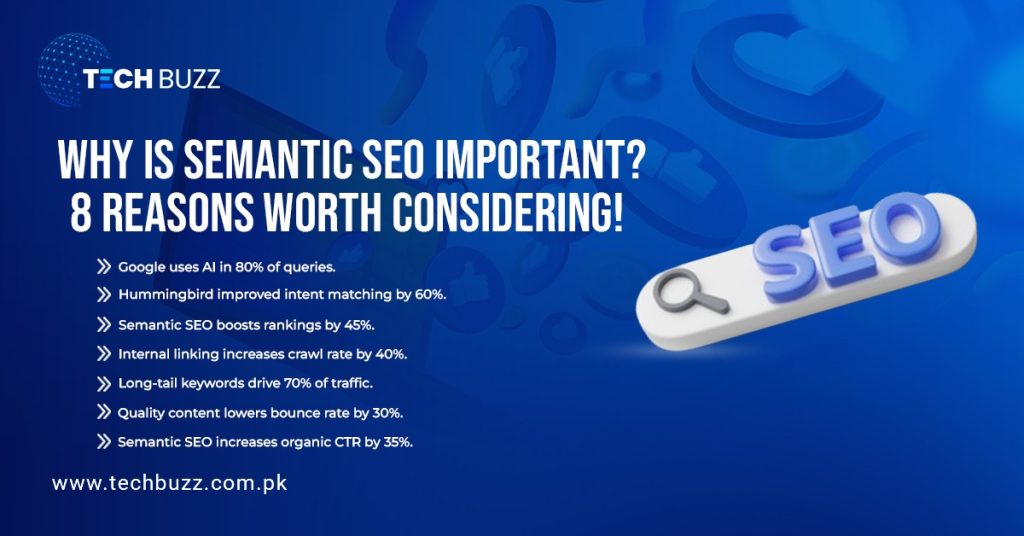
Over time, search engines have evolved through AI and machine learning advancements. Google’s algorithm updates continue to reshape how search results are ranked and delivered.
- However, Hummingbird has left a deep mark on Google by combining new and old techniques. It helped focus on providing improved search engine results and prefers quality content or quantity keywords.
- It helps Google understand user intent beyond keywords by focusing on topics, improving your content’s SERP performance, traffic, and overall visibility.
- It also ensures that your website appears as an expert in the specific topic you’re discussing. You can use high-quality and better-ranking internal links in such relevant topics to improve your website’s growth.
- Users like to click on such websites that appear with their relevant Long Tail Keywords. They spend a great time exploring the website and find relevant solutions and content. This way, the engagement and click rates on your website increase. Users have fewer chances to encounter websites and content that only focus on keyword stuffing and low-quality content.
- Search algorithms enhance user experience by delivering relevant content and helping sites improve rankings and build authority.
- You can avoid using low-level and spammy content with lots of keyword stuffing. Instead, you’ll focus on crafting high-quality content. That is relevant, worthy, and easy to rank on search engines with better chances of organic CTR.
- Use relevant or semantic SEO keywords related to your main topic. For example, “hair products” includes shampoo, conditioner, and hair gel; these related terms help improve keyword relevance and search rankings.
- You should know that semantic keywords are not always synonymous with your main topic. You need to do a thorough keyword research and craft a suitable plan accordingly.
Keyword Research Strategy For Finding Semantic Keywords
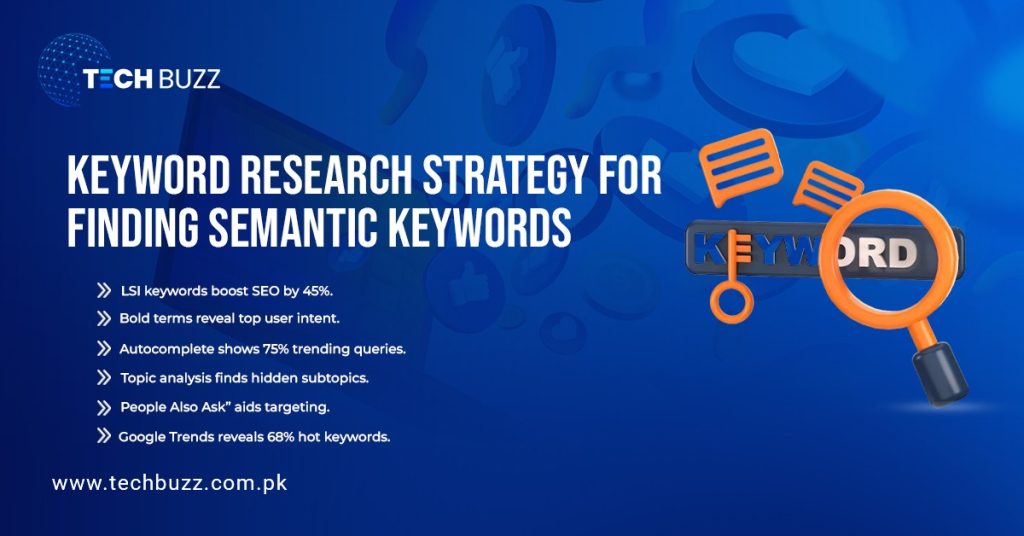
When you want to rank your content and ensure your relevant audience can find that content. Using semantic SEO keywords in your content becomes necessary. These keywords are also known as LSI keywords. You can do this through multiple measures.
- Pay attention to the bold terms and phrases in search results on Google. They are specific topics that people search for and want solutions for their searches.
- You can also type your focus keyword and let Google autocomplete provide you with multiple suggestions. These are the latest and top trending topics that users search actively on Google.
- Try using the topic analysis method. It helps you uncover the underlying themes and subtopics within the main topic. Consider relevant words and phrases that match your searches.
- You can find various topics and keywords when you go to the end of the Google search page. They are the alternative terms and phrases that users search for.
- You may have seen countless times the bolded section in the search results with the heading “People also ask.” Check out different queries related to your main keyword. Then, use these phrases and terms for better outputs. This proves a free SEO analysis strategy.
- Many users interested in SEO analysis check out the current Google Trends or hot topics. You can search topics related to your main keywords. This method is essential for finding various kinds of keywords and long-tail phrases that help in ranking.
Understanding The Key Elements Of Intent-Based SEO
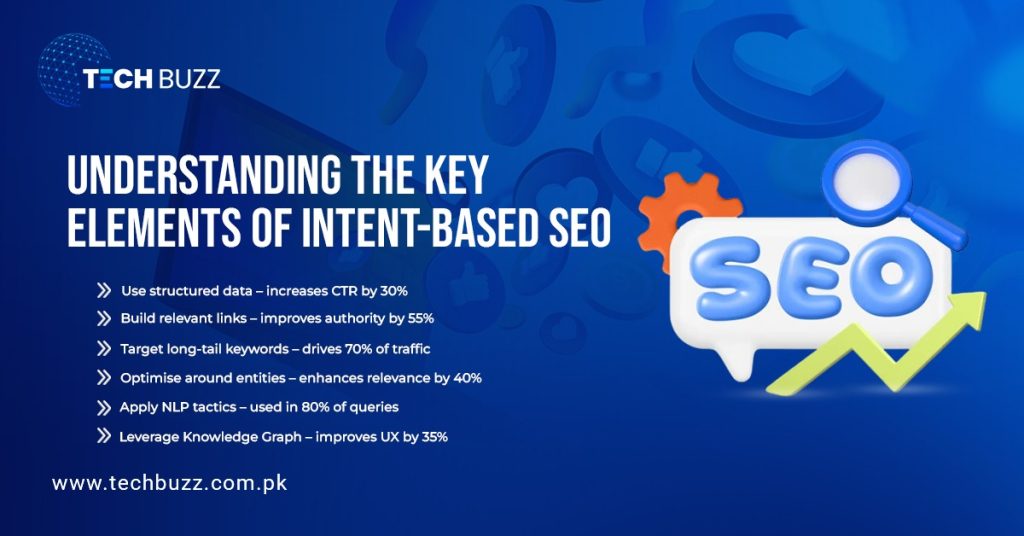
Different elements in intent-based SEO help search engines and users understand your content smoothly. Such elements work together for the improvement of your website’s authority, relevancy, and content discovery.
Structured Data
You need to add topic clusters, long and in-depth content, in a structured way.
- When you have proper headings, subheadings, images, and links. It becomes easy for search engines and users to read and understand your content.
- You must add semantic HTML tags to identify your website’s content and different sections. It is also known as schema markup coding.
- It becomes easier for search engines to understand the context this way. Your content becomes digestible.
- Provide comprehensive details about the keywords you cover rather than just adding the keywords in your content. It is beneficial for your SEO performance.
- Adding additional valuable content like Google reviews, recipes, and proper details proves an addition of rich snippets in your content. They are highly effective in intent-based SEO.
Link Building
These links are different from your main keyword but still resonate with the entire topic. Instead of just using LSI keyword-based links, using semantic-based links that connect with the entire topic is suggested. Link building techniques mean you have to find websites that are relevant to the keywords. And have content for which you are linking your page.
Long Tail Keywords
General keywords are more than three words. They are more or less popular at the same time. They are undermining gems that most users ignore while ranking their content. You can target such keywords to find your specific audience and make your content further relevant.
Entities
You must focus on optimising your content around entities, including:
- Places.
- People.
- Things.
- Ideas.
Search engines understand these entities. When you make your content around them, search engines can understand your content better.
Natural Language Processing Tactics
NLP is a form of AI and is used in intent-based SEO. To understand the phrases, queries, and intentions behind simple keywords. It’s not limited to just simple main keywords. Now, SEO and search engines are advanced. They use NLP tactics to understand the entire subject of your content within minutes.
Google’s Knowledge Graph
When users need instant results without clicking on multiple websites and links, the Knowledge Graph proves essential. It is different from the traditional search results. It offers direct results to users’ searches or queries rather than providing website options. Knowledge Graph provides specific facts and highlights topics according to users’ search requirements. This is an essential way to improve the overall user experience on search engines.
Semantic SEO And Mobile SEO Connection
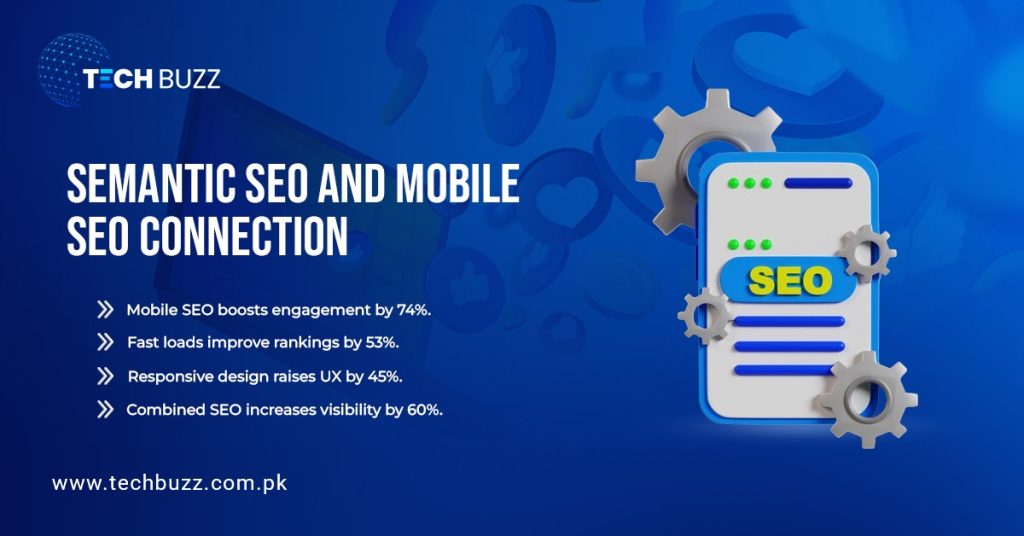
Although they have different aspects, they improve user experience and help in ranking well on search engines. Mobile SEO involves the optimisation of a website for users who prefer using mobile devices like tablets, smartphones, etc. It is a key aspect of technical SEO, which is a component of a broader intent-based SEO strategy.
This method helps in ensuring the website is:
- Responsive.
- Loads quickly.
- Easy navigation.
- Mobile-friendly content.
Intent-based SEO simplifies the meaning and context of the website’s content to provide more meaningful and advanced results. A successful SEO approach is completed when it involves both of these components. When you implement them in your content, you can improve your user experience and rank well, too.
Conversational Keywords In Intent-Based SEO
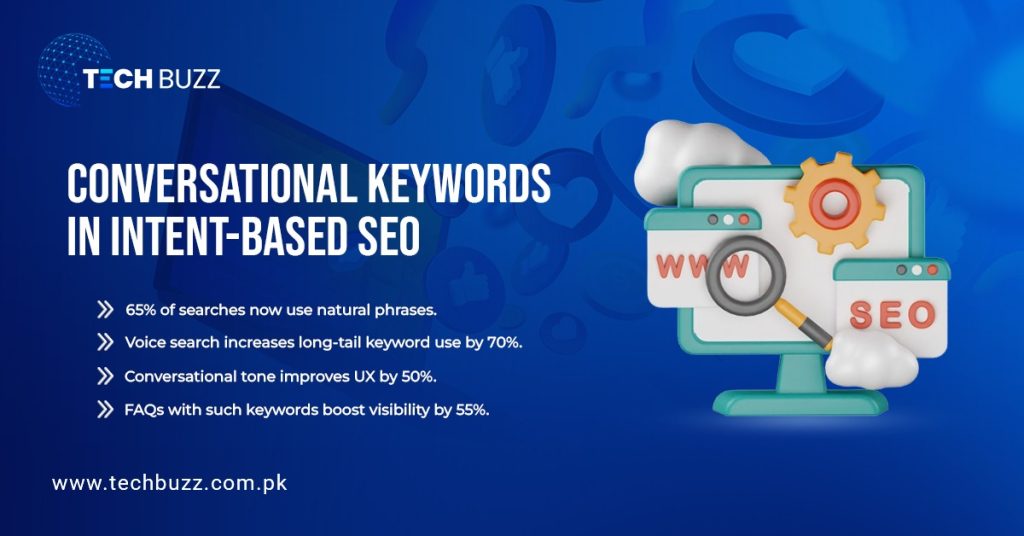
These are phrases or keywords that mimic the way humans naturally speak. Full questions and long phrases are included in these keywords. They are not one or two-word keywords or short phrases. It’s just like you talk when you use voice search engines. Or talk to Alexa, Siri, and even ChatGPT. You will have a conversation with these search engines just like you do with a human.
Although you are lazy to type stuff, you have to speak properly to get accurate results. That’s why the normal length of a search query is increasing. The phrases and algorithms connected with this procedure are also transforming. You can use conversational keywords in your intent-based SEO strategy by:
- Writing in a friendly and natural tone rather than being a robotic version of yourself.
- Answer queries directly with clear and concise responses rather than providing lengthy paragraphs about multiple topics.
- Add long-tail keywords in your content because your users prefer them to get accurate results.
Semantic and conversational SEO are interconnected in several ways. They are important for a better user experience. They help search engines understand the entire topic rather than focusing on a single keyword. You can use conversational keywords in FAQs, short paragraphs, and tips for better responses. The trend of voice searches is also gaining continuous popularity, including phrases and keywords that are conversational.
Consider These Incredible 4 Google Ranking Factors In Semantic SEO
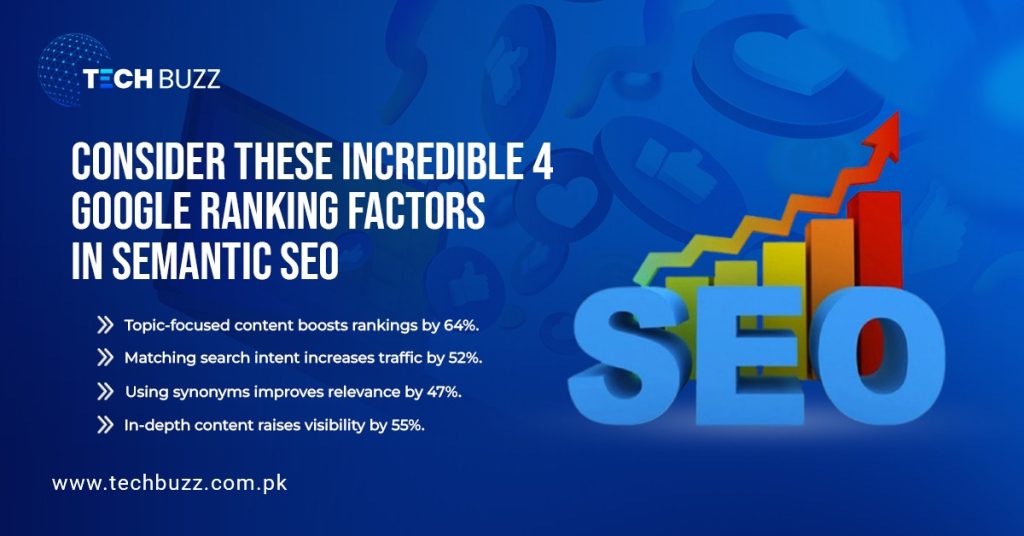
You can maximise the impact of your semantic SEO tactics in your content when you follow the given tips.
Focus On Topics Rather Than Keywords
Choose broad topics rather than focusing on specific keywords. Google now understands that you are using similar keywords to rank well. But you have to change your strategy. You need to focus on different types of keywords and topics that are interconnected.
We can rank well on such content because you have crafted detailed content on topics, not just single keywords. You can match the user intent and cover the subject properly. However, that doesn’t mean you have to cover everything and head deep into the topic. Cover it in good length and provide accurate details that your users can digest without too much hassle.
Understand The Main Search Intent
You need to create content that aligns with your users’ requirements and searches. You can use different SEO optimisation tools for this purpose. They can save time and effort while providing a detailed overview of keywords you can use in your content.
Synonyms And Related Keywords, And Terms
Although AI and NLP advancements have made Google too developed to understand what type of synonyms you use in your content. You need to add some related terms and keywords, along with synonyms, smoothly into your content. Don’t stuff keywords in your content. Add them naturally so they become an integral part of your content.
Improve Content Length And Topical Depth
Improve your content length and make it longer. However, ensure they are to-the-point content coverage without any additional information. You can also update your old content by adding trending intent-based keywords. Don’t remove ranking keywords during this procedure from your old content.
Add Semantic SEO Strategies To Your Content With TechBuzz
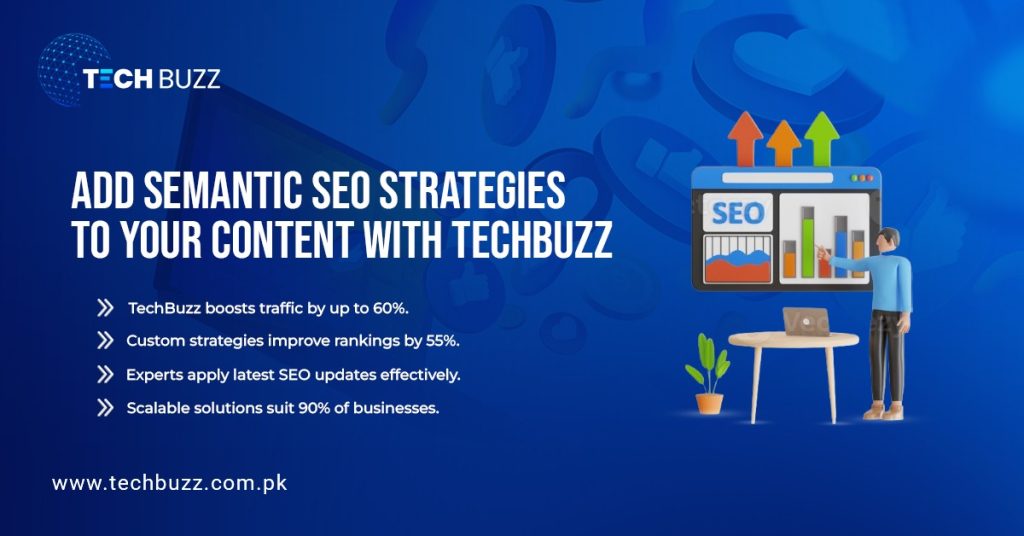
Techbuzz is a digital marketing agency in Lahore, Pakistan. It offers various kinds of services, including SEO.
- The professionals and experienced SEO experts from this agency can help you drive better traffic, conversions, and rankings.
- They can create personalised strategies to work on specific weaknesses that are affecting your rankings.
- They provide proven results in intent-based SEO optimisation.
- Their SEO experts are aware of new and trending SEO algorithms and updates.
- They offer affordable and scalable solutions for all-sized businesses.
Contact us today for a one-on-one discussion.
Conclusion
To conclude, semantic SEO is a necessary procedure for every business that wants to stand out in the digital world. When you align your content according to your users’ preferences and Google requirements, you can improve your rankings and traffic rates. Your users feel satisfied with your services. You need to embrace the changes in SEO and follow the flow to make your content visible.

